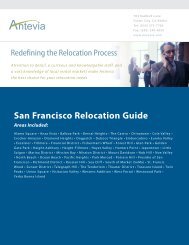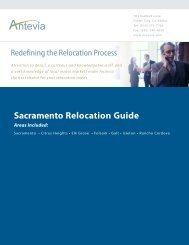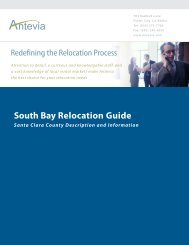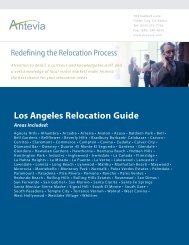Los Angeles Relocation Guide - Antevia
Los Angeles Relocation Guide - Antevia
Los Angeles Relocation Guide - Antevia
- No tags were found...
You also want an ePaper? Increase the reach of your titles
YUMPU automatically turns print PDFs into web optimized ePapers that Google loves.
In the meantime, the United States Department of Commerce recommended Burbank asthe most favorable airport location in the <strong>Los</strong> <strong>Angeles</strong> area. Dedicated on Memorial DayWeekend (May 30 - June 1), 1930, the United Airport was the largest commercial airportin the <strong>Los</strong> <strong>Angeles</strong> area until it was eclipsed in 1946 by the <strong>Los</strong> <strong>Angeles</strong> MunicipalAirport in Inglewood when that facility (the former Mines Field) commenced commercialoperations.Burbank's airport has undergone a number of name changes since its opening day in1930. It remained United Airport until 1934, when it was renamed Union Air Terminal(1934-1940). Lockheed bought the airport in 1940 and renamed it the Lockheed AirTerminal, which it was known as until 1967, when its name changed again, toHollywood-Burbank Airport. It remained Hollywood-Burbank Airport for over a decade,until 1978, when it was renamed Burbank-Glendale-Pasadena Airport (1978-2003).Most recently, in December of 2003, the facility was renamed Bob Hope Airport in honorof the famous comedian (see "Burbank Today" below).The growth of companies such as Lockheed and the burgeoning entertainment industrydrew more and more people to the area as Burbank's population doubled again between1930 and 1940 to 34,337. But Burbank saw its greatest growth during World War II dueto Lockheed's strong presence in the city, employing some 80,800 men and women tocontribute to the war effort producing aircraft such as the Hudson, P-38 Lightning, PV-1Ventura and America's first jet fighter, the P-80 Shooting Star, arriving too late toparticipate in the war, but would see service in the Korean War, logging the world's firstjet-to-jet aerial kill in history. Lockheed would go on to produce the super secret spyplanes U2, SR-71 Blackbird and the F-117 Nighthawk at its Burbank-based "SkunkWorks."Burbank companies were involved throughout the war, joining together on this P-38Disney and Warner (formerly First National Studio) contributed to the war effort byproducing training films and morale films for the armed services and cartoons promotingthe sale of war bonds. Disney artists designed more than 1000 unit mascot designs forunits from every branch of the armed forces. Walt Disney had authorized that the creationof these insignias were to be designed for free and by the end of the war was estimated tohave cost Disney over thirty thousand dollars.Burbank would also witness its first real civil strife as the culmination of a six monthlabor dispute between the Set Decorator's union and the studios resulted in the Battle ofBurbank on October 5, 1945.







